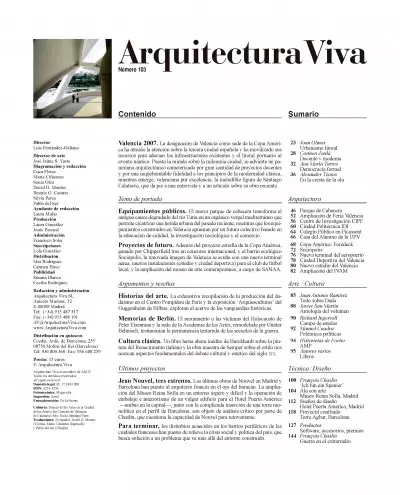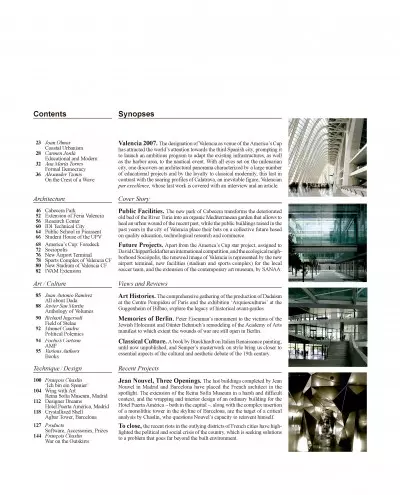Synopses
Valencia 2007. The designation of Valencia as venue of the America’s Cup has attracted the world’s attention towards the third Spanish city, prompting it to launch an ambitious program to adapt the existing infrastructures, as well as the harbor area, to the nautical event. With all eyes set on the milenarian city, one discovers an architectural panorama characterized by a large number of educational projects and by the loyalty to classical modernity, this last in contrast with the soaring profiles of Calatrava, an inevitable figure, Valencian par excellence, whose last work is covered with an interview and an article. .
Contents
Joan Olmos
Coastal Urbanism
Carmen Jordá
Educational and Modern
Ana María Torres
Formal Democracy
Alexander Tzonis
On the Crest of a Wave
Cover Story
Public Facilities. The new park of Cabecera transforms the deteriorated old bed of the River Turia into an organic Mediterranean garden that allows to heal an urban wound of the recent past, while the public buildings raised in the past years in the city of Valencia place their bets on a collective future based on quality education, technological research and commerce.
Architecture
Cabecera Park
Extension of Feria Valencia
Research Center
IDI Technical City
Public School in Picassent
Student House of the UPV
Future Projects. Apart from the America’s Cup star project, assigned to David Chipperfield after an international competition, and the ecological neighborhood Sociópolis, the renewed image of Valencia is represented by the new airport terminal, new facilities (stadium and sports complex) for the local soccer team, and the extension of the contemporary art museum, by SANAA.
America’s Cup: Foredeck
Sociópolis
New Airport Terminal
Sports Complex of Valencia CF
New Stadium of Valencia CF
IVAM Extension
Views and Reviews
Art Histories. The comprehensive gathering of the production of Dadaism at the Centre Pompidou of Paris and the exhibition ‘Arquiesculturas’ at the Guggenheim of Bilbao, explore the legacy of historical avant-gardes.
Art / Culture
Juan Antonio Ramírez
All about Dada
Javier San Martín
Anthology of Volumes
Memories of Berlin. Peter Eisenman’s monument to the victims of the Jewish Holocaust and Günter Behnisch’s remodeling of the Academy of Arts manifest to which extent the wounds of war are still open in Berlin.Richard Ingersoll
Field of Stelae
Manuel Cuadra
Political PolemicsFocho’s Cartoon
AMP
Various Authors
BooksClassical Culture. A book by Burckhardt on Italian Renaissance painting, until now unpublished, and Semper’s masterwork on style bring us closer to essential aspects of the cultural and aesthetic debate of the 19th century.Recent Projects
Jean Nouvel, Three Openings. The last buildings completed by Jean Nouvel in Madrid and Barcelona have placed the French architect in the spotlight. The extension of the Reina Sofía Museum in a harsh and difficult context, and the wrapping and interior design of an ordinary building for the Hotel Puerta América – both in the capital –, along with the complex insertion of a monolithic tower in the skyline of Barcelona, are the target of a critical analysis by Chaslin, who questions Nouvel’s capacity to reinvent himself.
Technique / Style
François Chaslin
‘Ich bin ein Spanier’
Wing with Art
Reina Sofía Museum, Madrid
Designer Dreams
Hotel Puerta América, Madrid
Crystallized Shell
Agbar Tower, Barcelona
To close, the recent riots in the outlying districts of French cities have highlighted the political and social crisis of the country, which is seeking solutions to a problem that goes far beyond the built environment.Products
Software, Accessories, Prizes
François Chaslin
War on the Outskirts
Luis Fernández-Galiano
Valencia 2007
Spectacle builds the city. Both big sports events and Expos have an urban dimension that turns them into milestones of architectural experiment. Spain saw this in 1992, when the coincidence of the Olympic Games of Barcelona and the Universal Exposition of Seville supplied a handful of built landmarks for the best PR campaign of its history. Madrid’s recent vie with Moscow, New York, Paris and London, with the final victory of the British, to host the Games of 2012 illustrates the urban cravings provoked by high-profile sport, economic engine and symbolic bait to obtain public funds that may be thematized through collective pride. Thus, the architectural calendar of the near future includes the World Cup of Germany in 2006, the America’s Cup of Valencia in 2007 and the Olympic Games of Beijing in 2008 (also the year of the Zaragoza Expo), three sports and media events that shall mark the coming summers, forever changing their host cities.
In the case of Valencia, its designation in 2002 as venue for the oldest and most important yacht race – that many describe as the Formula 1 of the sea –, among more than sixty candidate cities, has a double character: on the one hand, it reflects the ambition, dynamism and determination of the third Spanish city, able to compete successfully in the demanding urban leagues for the organization of planetary events; on the other, it provides an alibi to boost its large projects of urban renewal and to show the world its accomplishments. The unprecedented circumstance of the last winner of the America’s Cup being from Switzerland, a landlocked country, has given Valencia the extraordinary opportunity to redesign its obsolete seafront, as well as the chance to improve its transport network, from airport to subway, and perhaps also an excuse to urge the central administration to expedite the arrival of the high-speed train to a city and a port of increasing economic relevance.
We cannot discuss Valencia without mentioning Calatrava, an architect and engineer that has made himself as inseparable from the local image as the paella or the fallas, and this in spite of the fact that his house and studio are outside Spain, his oeuvre has an international scope, and his sculptural forms serve as logos for very different institutions or cities. Though Martin Filler in The New York Review of Books may describe him as halfway between Disney and Gehry, Ada Louise Huxtable in The Wall Street Journal as “dangerously close to kitsch”, and Edwin Heathcote in The Financial Times as a victim of the ‘icon syndrome’, the Valencian is the first architect to exhibit in New York’s Metropolitan since Breuer in 1972, and his soaring populism a manifestation of contemporary spectacle, as rooted in his time as Fra Angelico or Van Gogh, exhibited next to him, were in theirs. Valencia’s luminous and sensual energy is not only represented by Calatrava, but his work is indeed worthy of this dazzling and exuberant city.








